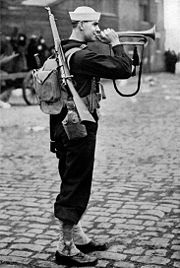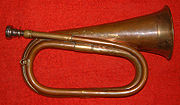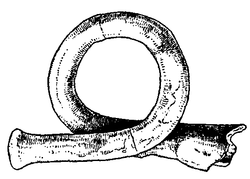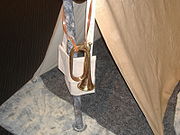
Bugle (instrument)
Encyclopedia

Brass instrument
A brass instrument is a musical instrument whose sound is produced by sympathetic vibration of air in a tubular resonator in sympathy with the vibration of the player's lips...
s, having no valves or other pitch-altering devices. All pitch
Pitch (music)
Pitch is an auditory perceptual property that allows the ordering of sounds on a frequency-related scale.Pitches are compared as "higher" and "lower" in the sense associated with musical melodies,...
control is done by varying the player's embouchure
Embouchure
The embouchure is the use of facial muscles and the shaping of the lips to the mouthpiece of woodwind instruments or the mouthpiece of the brass instruments.The word is of French origin and is related to the root bouche , 'mouth'....
, since the bugle has no other mechanism for controlling pitch. Consequently, the bugle is limited to note
Note
In music, the term note has two primary meanings:#A sign used in musical notation to represent the relative duration and pitch of a sound;#A pitched sound itself....
s within the harmonic series
Harmonic series (music)
Pitched musical instruments are often based on an approximate harmonic oscillator such as a string or a column of air, which oscillates at numerous frequencies simultaneously. At these resonant frequencies, waves travel in both directions along the string or air column, reinforcing and canceling...
. See bugle call
Bugle call
A bugle call is a short tune, originating as a military signal announcing scheduled and certain non-scheduled events on a military installation, battlefield, or ship. Historically, bugles, drums, and other loud musical instruments were used for clear communication in the noise and confusion of a...
for scores to standard bugle calls, which all consist of only five notes.
History

Post horn
The post horn is a valveless cylindrical brass or copper instrument with cupped mouthpiece, used to signal the arrival or departure of a post rider or mail coach...
, the Pless horn (sometimes called the "Prince Pless horn"), and the bugle horn.
The first verifiable formal use of a brass horn as a military signal device was the Halbmondbläser – literally, "half moon blower" – used in Hanover
Hanover
Hanover or Hannover, on the river Leine, is the capital of the federal state of Lower Saxony , Germany and was once by personal union the family seat of the Hanoverian Kings of Great Britain, under their title as the dukes of Brunswick-Lüneburg...
in 1758. It was U-shaped (hence its name) and comfortably carried by a shoulder strap attached at the mouthpiece and bell. It first spread to England in 1764 where it was gradually accepted widely in foot regiments. Cavalry did not normally use a proper bugle, but rather an early trumpet that might be mistaken for a bugle today, as it lacked keys or valves, but had a more gradual taper and a smaller bell, producing a sound more easily audible at close range but with less carrying power over distance.
Uses

Bugle call
A bugle call is a short tune, originating as a military signal announcing scheduled and certain non-scheduled events on a military installation, battlefield, or ship. Historically, bugles, drums, and other loud musical instruments were used for clear communication in the noise and confusion of a...
is used to indicate the daily routines of camp. Historically the bugle was used in the cavalry to relay instructions from officers to soldiers during battle. Biblically, bugles are found in the time of Moses, when God commanded Moses to 'make two bugles of hammered silver' in Numbers 10:1-3. They were used to assemble the leaders and to give marching orders to the camps.
The bugle is also used to play Taps
Taps
"Taps" is a musical piece sounded by the U.S. military nightly to indicate that it is "lights out". The tune is also sometimes known as "Butterfields Lullaby", or by the lyrics of its second verse, "Day is Done". It is also played during flag ceremonies and funerals, generally on bugle or trumpet...
or the Last Post
Last Post
The "Last Post" can be either a B♭ bugle call within British Infantry regiments or an E♭ cavalry trumpet call in British Cavalry and Royal Regiment of Artillery used at Commonwealth military funerals and ceremonies commemorating those who have been killed in war.The two regimental traditions have...
in military rites
Military rites
Military rites are honors presented at a funeral for a member of a military or police force. These rites, which are performed at the burial, include the firing of rifles, presenting of a flag and or bugle calls. In Australia and New Zealand a Poppy Service is often held for members of the Armed...
at funerals
Military funeral
A military funeral is a specially orchestrated funeral given by a country's military for a soldier, sailor, marine or airman who died in battle, a veteran, or other prominent military figures or heads of state. A military funeral may feature guards of honor, the firing of volley shots as a salute,...
.
In modern drum and bugle corps
Drum and bugle corps (modern)
A drum and bugle corps, also known as a drum corps, is a musical marching unit consisting of brass instruments, percussion instruments, and color guard. Typically operating as independent non-profit organizations, drum corps perform in competitions, parades, festivals, and other civic functions...
, the bugle has moved away from its military origins, including the use of valves. In American drum and bugle corps, G was the traditional key for bugles to be pitched in through the year 2000. However, current rules in both Drum Corps International
Drum Corps International
Drum Corps International , formed in 1972, is the non-profit governing body operating the North American drum and bugle corps circuit for junior corps, whose members are between the ages of 14 and 21. It is the counterpart of Drum Corps Associates which governs senior or all-age drum corps...
and Drum Corps Associates
Drum Corps Associates
Drum Corps Associates is the governing body for modern senior or all-age drum and bugle corps in North America. It is the counterpart of Drum Corps International which governs junior drum corps...
define a bugle as a brass instrument in any key, with 0 to 4 valves, and bell front. Typically, drum corps brass is in G or B flat, with mellophones in B flat brass lines being in the key of F.
Civilian drum corps were founded using equipment sold off by the military in the early 1900s, and the last official change made to the military bugle (before its role as a signaling device was rendered obsolete by the radio) was to standardize them in the key of G. Bugles in other parts of the world typically were pitched in B flat or E flat.
A challenge for those attempting to define bugles with such a general classification is to explain how bugles are different from any other kind of brass band instrument. The standardized American G military bugle has been replaced with B-flat instruments by the majority of drum and bugle corps
Drum and bugle corps (modern)
A drum and bugle corps, also known as a drum corps, is a musical marching unit consisting of brass instruments, percussion instruments, and color guard. Typically operating as independent non-profit organizations, drum corps perform in competitions, parades, festivals, and other civic functions...
.
The bugle is also used in Boy Scout troops and in the Boys' Brigade. They use many of the same calls as the military does, but not as many.
Variations

Cornet
The cornet is a brass instrument very similar to the trumpet, distinguished by its conical bore, compact shape, and mellower tone quality. The most common cornet is a transposing instrument in B. It is not related to the renaissance and early baroque cornett or cornetto.-History:The cornet was...
is sometimes erroneously considered to be the "valved version" of the bugle, although it was derived from the French cornet de poste (post horn
Post horn
The post horn is a valveless cylindrical brass or copper instrument with cupped mouthpiece, used to signal the arrival or departure of a post rider or mail coach...
).
19th century variants based on the standard bugle included keyed bugles and valved bugles. Keyed bugles were invented in England in the early 19th century, with a patent for one design, the Royal Kent bugle, taken out by Joseph Halliday in 1811. This bugle was highly popular and widely in use until c. 1850 – for example, in works by Richard Willis, later bandmaster of the United States Military Academy
United States Military Academy
The United States Military Academy at West Point is a four-year coeducational federal service academy located at West Point, New York. The academy sits on scenic high ground overlooking the Hudson River, north of New York City...
Band at West Point. This variant of the bugle fell out of use with the invention of the valved cornet
Cornet
The cornet is a brass instrument very similar to the trumpet, distinguished by its conical bore, compact shape, and mellower tone quality. The most common cornet is a transposing instrument in B. It is not related to the renaissance and early baroque cornett or cornetto.-History:The cornet was...
.
Modern instruments classified as bugles are often valved.
Pitches of bugles
- Soprano bugle (high pitch)
- Alto bugle (medium pitch)
- Baritone bugle (tenor pitch)
- Contrabass bugleContrabass BugleThe contrabass bugle, usually shortened to contra, is the lowest-pitched instrument in the drum and bugle corps hornline. It is essentially the drum corps' counterpart to the marching band's sousaphone: the lowest-pitched member of the hornline, and a replacement for the concert tuba on the...
(bass pitch)
External links
- Evolution of the Bugle
- Bugle in C by Thomas Key and William Trayls, London, 1811 at The Metropolitan Museum of Art

